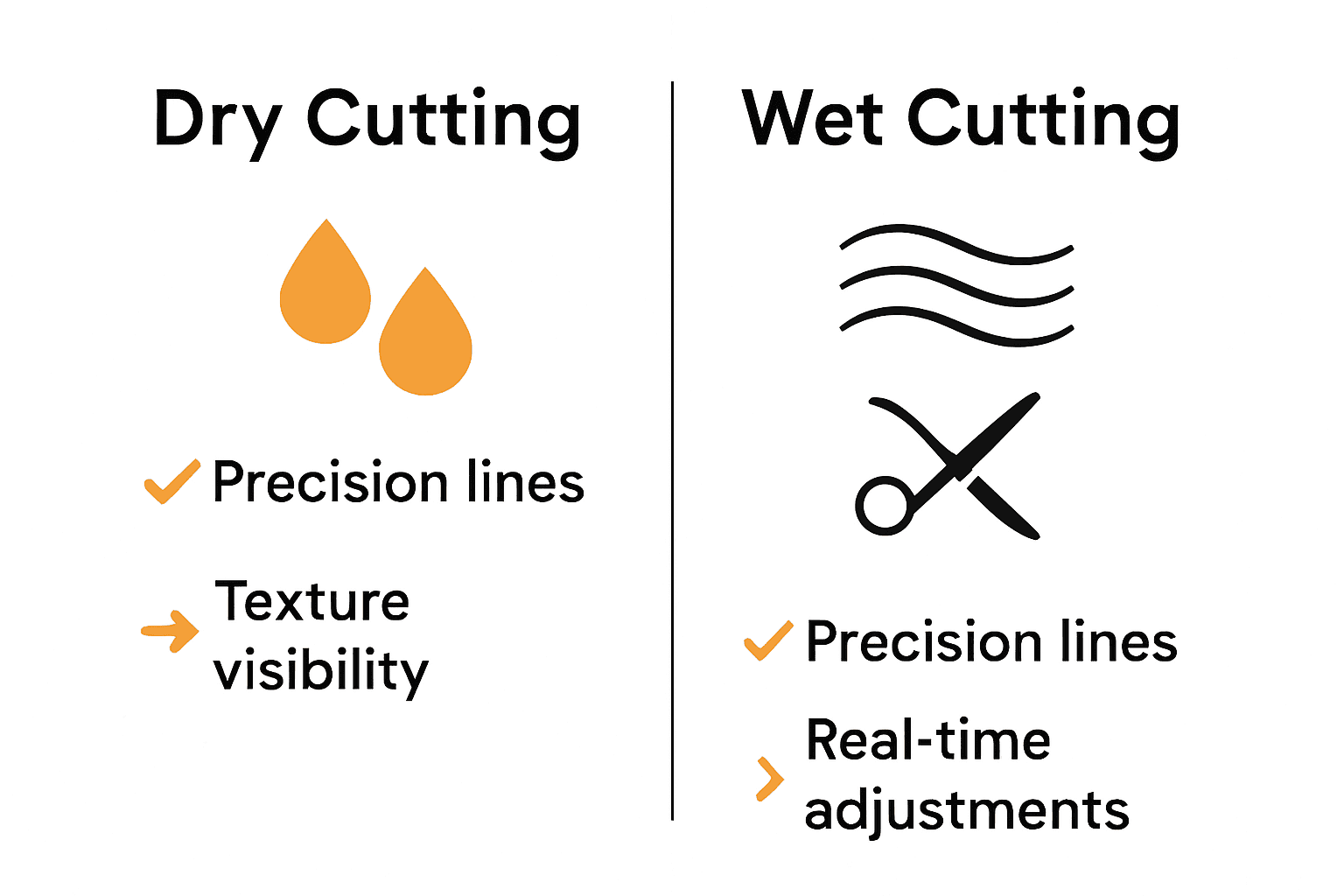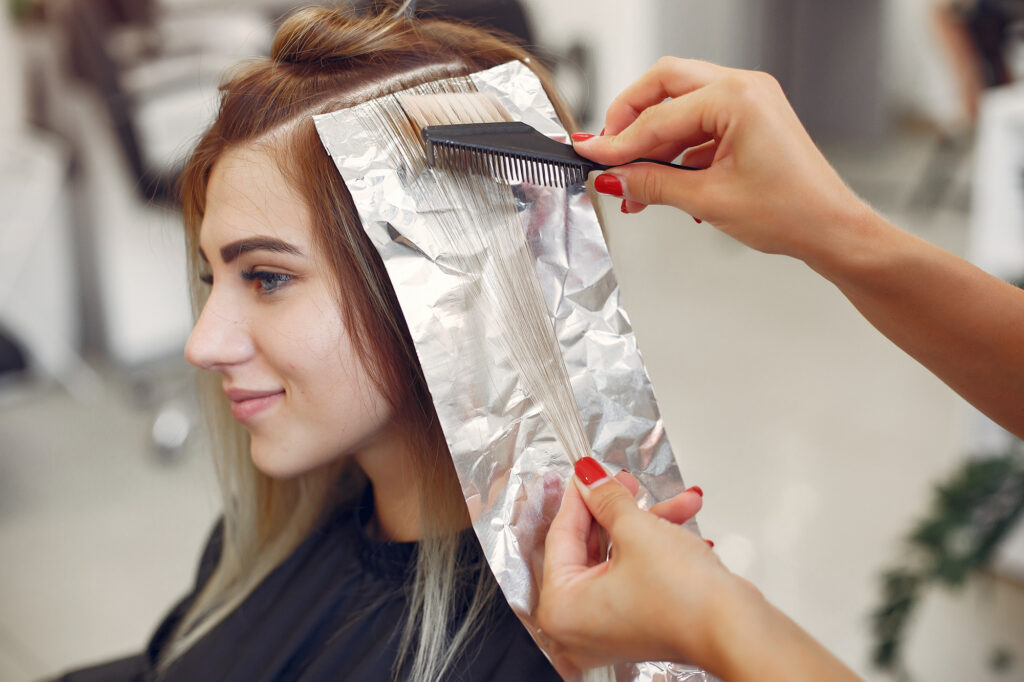What Is Dry Cutting? Complete Salon Expert Guide

More than 60 percent of american salon clients say that a truly personalized haircut makes a lasting impression. Finding the right approach to match individual hair texture and style can be a challenge for both clients and stylists. Dry cutting has become a powerful solution, giving professional hairstylists a way to craft unique and flattering results while honoring each person’s natural hair movement and volume.
Table of Contents
- Defining Dry Cutting In Hairdressing
- Techniques And Tools For Dry Cutting
- Benefits And Ideal Candidates For Dry Cutting
- Comparing Dry Cutting Vs. Wet Cutting
- Common Mistakes And Professional Advice
Key Takeaways
| Point | Details |
|---|---|
| Understanding Dry Cutting | Dry cutting allows hairstylists to work with hair in its natural state, offering precise control and the ability to see how hair moves and falls. |
| Techniques and Tools | Specialized techniques like skimming and point cutting, along with high-quality shears, enhance the effectiveness of dry cutting for personalized styling. |
| Ideal Candidates | Dry cutting is particularly beneficial for clients with fine or straight hair, seeking detailed, textured, and personalized haircuts. |
| Avoiding Common Mistakes | Successful dry cutting requires sharp tools and careful technique to avoid damaging hair and ensure the desired final style. |
Defining Dry Cutting in Hairdressing
Dry cutting is a sophisticated hair styling technique that transforms traditional haircutting approaches. According to Shihan Shears, dry cutting involves trimming hair in its natural, dry state, which allows stylists to assess the hair’s true texture, movement, and volume during the cutting process.
This innovative technique provides hairstylists with unparalleled precision and control. Dry cutting enables professionals to observe hair’s authentic behavior, revealing how each strand naturally falls and moves. By working with hair in its untouched, dry state, stylists can make more informed decisions about shape, length, and style. As Michiko Shears explains, the technique is particularly beneficial for enhancing texture and achieving precise styling results.
Key characteristics of dry cutting include:
- Immediate visual assessment of hair’s natural state
- Enhanced ability to understand individual hair patterns
- Precise tailoring of cuts to match natural hair movement
- Greater control over final styling outcomes
Professional hairstylists appreciate dry cutting for its ability to create more personalized and flattering haircuts. Unlike traditional wet cutting methods, this approach respects the unique characteristics of each individual’s hair, resulting in more natural and customized styles that beautifully complement personal features and hair textures.
Techniques and Tools for Dry Cutting
Dry cutting requires specialized techniques and precision tools that elevate the hairstyling process. According to Wella Professionals, effective dry cutting involves advanced techniques like skimming with a feather blade to remove weight and add texture, and filtering with texturizing shears to refine the haircut without compromising length.
Professional stylists employ multiple nuanced techniques to achieve exceptional results. Skimming involves using razor-sharp scissors to gently remove excess weight, creating movement and softness. Point cutting allows stylists to create seamless layers and reduce bulk by cutting into the hair at an angle, which prevents harsh lines and promotes natural-looking texture. Texturizing techniques help create dimension and personalize each haircut to the client’s unique hair characteristics.
Key dry cutting techniques include:
- Skimming with precision blades
- Point cutting for soft layering
- Texturizing to enhance hair movement
- Detailed sectioning and careful angle management
Choosing the right tools is critical for dry cutting success. Saki Shears emphasizes that specialized scissors designed specifically for dry cutting can dramatically improve a stylist’s precision and comfort. Professional-grade shears with ergonomic designs and razor-sharp edges enable hairstylists to execute intricate cuts with minimal strain, ensuring both artistic excellence and personal comfort during complex styling sessions.

Benefits and Ideal Candidates for Dry Cutting
Dry cutting offers transformative advantages for individuals seeking personalized and precise hairstyling. According to Black House Education, this technique provides exceptional benefits such as working with the hair’s natural movement and texture, enabling precision detailing, and allowing for immediate on-the-spot customization, which is particularly advantageous for short haircuts.
Texture-specific styling becomes remarkably refined through dry cutting. Professional stylists can strategically assess and address each client’s unique hair characteristics, creating tailored solutions that traditional wet cutting methods cannot achieve. Scissor Warrior emphasizes that dry cutting is especially beneficial for clients with fine or straight hair, allowing stylists to precisely observe weight distribution and prevent over-removal of hair.
Ideal candidates for dry cutting include:
- Clients with fine or straight hair textures
- Individuals seeking highly personalized haircuts
- Those wanting to maintain natural hair movement
- People with intricate hair layering requirements
- Clients desiring precise, textured styling
Unlike traditional cutting methods, dry cutting empowers hairstylists to create truly individualized looks. By examining hair in its natural state, professionals can make real-time adjustments, ensuring the final style perfectly complements the client’s facial features, personal style, and unique hair characteristics. This approach transforms haircuts from standard procedures into personalized artistic expressions.
Comparing Dry Cutting vs. Wet Cutting
Hairstyling techniques vary dramatically between dry and wet cutting methods, each offering unique advantages for different hair types and desired outcomes. According to Rush, wet cutting is ideal for creating clean, precise lines and structured hairstyles, especially for straight or fine hair, while dry cutting allows stylists to work with the hair’s natural texture and movement, making it particularly suitable for layered and textured styles.
Wet cutting traditionally involves saturating hair with water to create uniform length and sharp lines. This method provides exceptional control for geometric cuts and enables stylists to see precise measurements. In contrast, dry cutting focuses on understanding hair’s natural behavior, allowing for more organic and personalized styling approaches. L’Oreal Paris highlights that dry cutting offers significant benefits for working with natural hair movement and is often preferred for curly or coily hair types.
Key differences between dry and wet cutting include:
- Precision of lines (wet cutting more precise)
- Ability to see natural hair movement (dry cutting superior)
- Suitability for different hair textures
- Styling flexibility and customization
- Level of hair shrinkage consideration
Professional stylists often recommend a hybrid approach, selecting cutting techniques based on individual hair characteristics, client preferences, and desired final aesthetic.
 By understanding the strengths of both methods, skilled hairstylists can create truly personalized and exceptional haircuts that celebrate each client’s unique hair texture and personal style.
By understanding the strengths of both methods, skilled hairstylists can create truly personalized and exceptional haircuts that celebrate each client’s unique hair texture and personal style.
Common Mistakes and Professional Advice
Dry cutting requires precision and expertise, with numerous potential pitfalls that can compromise the final hairstyle. Saki Shears warns that common mistakes include sliding shears too aggressively, which can cause significant hair damage, and using blunt or dull shears that prevent clean, precise cuts. Professional stylists understand that tool quality directly impacts hair health and styling outcomes.
Technique refinement is crucial in mastering dry cutting. Wella Professionals emphasizes the importance of using fresh, sharp blades when skimming and point cutting, particularly when working with texturizing shears to prevent removing excessive weight or length. Stylists must develop a delicate touch and keen eye for maintaining hair integrity while achieving the desired style.
Common dry cutting mistakes to avoid include:
- Using dull or low-quality cutting tools
- Cutting hair too aggressively
- Failing to assess hair texture beforehand
- Removing too much length or weight
- Neglecting client’s natural hair movement
Professional advice centers on continuous learning and precision. Successful dry cutting demands not just technical skill, but also an artistic understanding of how hair naturally falls, moves, and responds to different cutting techniques. Experienced stylists recommend regular tool maintenance, ongoing education, and developing a personalized approach that respects each client’s unique hair characteristics.
Experience the Precision of Dry Cutting at Joel C Ma Hair Studio
Understanding the unique challenges of dry cutting can transform your approach to hairstyling. This expert technique demands precision, insight into natural hair movement, and the right tools to highlight texture and individual style. If you value personalized haircuts that respect your hair’s natural flow and want to avoid common mistakes like uneven weight or overcutting, our team at Joel C Ma Hair Studio brings over 25 years of artistic mastery to perfect your look.

Discover how dry cutting can enhance your hairstyle by booking a personalized consultation with our skilled stylists. Visit Joel C Ma Hair Studio to explore our services and see real transformations that celebrate natural texture and bespoke styling. Elevate your haircut experience today and embrace the art of dry cutting with expert hands on your side.
Frequently Asked Questions
What is dry cutting in hairdressing?
Dry cutting is a hair styling technique that involves cutting hair in its natural, dry state. This method allows stylists to assess the true texture, movement, and volume of the hair for more precise and personalized haircuts.
What are the benefits of dry cutting compared to wet cutting?
Dry cutting offers several advantages, including the ability to see how hair naturally falls and moves. It’s particularly beneficial for textured hairstyles and allows for immediate customization, making it great for clients with fine or straight hair who seek more personalized cuts.
What techniques are used in dry cutting?
Techniques used in dry cutting include skimming, point cutting, and texturizing. Skimming removes excess weight, point cutting softens layers, and texturizing enhances movement and personalization of the haircut.
Who are the ideal candidates for dry cutting?
Ideal candidates for dry cutting are individuals with fine or straight hair, those seeking highly personalized haircuts, clients desiring to maintain natural hair movement, and people with intricate hair layering requirements.
Recommended
- Master Cutting Curly Hair Techniques for Stunning Styles – Joel C Ma Hair Studio
- The Ultimate Guide to Haircuts That Enhance Your Curls
- How to Fix Bad Haircut: Stylish Solutions for 2025 – Joel C Ma Hair Studio
- Barber or Stylist? How to Choose the Right Professional for You
- What Is Dry Cleaning? Complete Expert Guide | Laundry Tips





